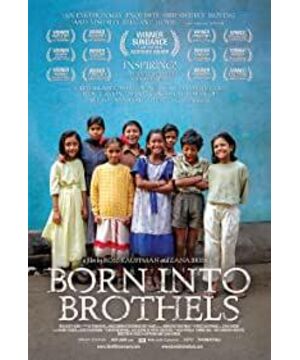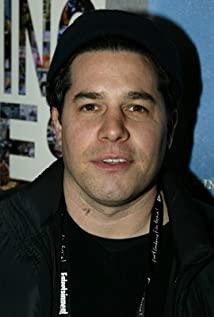While commercial film still has possibility to create arts out of reality, documentary need to be faithful to the life itself; at the same time, gaining some power from it to make a change for reality. Born into Brothers (2005) is a film which documents the real life of kids who were born and raised in red-lights district. It is a place full of poverty and disease; people living here hold no hope for future. And the worst is the kids of sex workers who not only suffer from others' discrimination, but also can do nothing to change their life. The darkness future has been doomed to them from the beginning. Zana Briski, a director and photographer from western country, light their life with a small camera. She found eight kids of prostitutes, teaching them how to use camera, encouraging them to take pictures in the streets.These precise instruments create an innocent place in the darkness community.
This film provides us a different perspective of sex worker's kids. The theme of the film neither led us to think of red-lights district in traditionally ways, nor just narrate factually and unimaginatively how the kids take pictures. It inserts the opinions of kids themselves . Zana prefer listening to the deep heart voice of those kids which store much more things than children in ordinary life.
Children are artist inborn if you open a door for them. Several plots in the movie impressed me. At the beginning, Zana let kids take photos for each other in narratage to introduce eight characters. I notice their expressive way when make comments to others. All the sentences are negative, “She never bother others; he never makes any trouble; he never mad at anyone” to make compliments as others' characters. Their words reflect low self-esteem which indicates lacking of “clear and positive identity” ( Catalano et al, 2004, p. 106). They may have been used to mother's yelling and the pimps' rudeness. As a result, they deeply believe it is such a good nature to be never mad at anyone. Their words seems telling“ we hope we are not redundant”. What a pathetic!
As we all know, the environment plays an important role in positive youth development. One of the forty developmental assets is to provide safe and comfort context for youth. Family support as the top of external assets means family life provides high level of love and support to Besides, positive family communication and caring neighborhood contribute a lot to children's development ( ). However, none of these assets can be seen in the kids living in red-light district.
In the film, when Zana negotiate with kids' mother to send them to school or go to another place, nearly all of mothers want to get rid of them who seems like the trouble and burden. When all the kids leaving home to school, only one of the girls cry while all others sing a song and be happy to leave. They were eager to get out of that live but lack of opportunity. Bond between parents and kid are so weak. For those sex worker mothers, not mention care and love, it is hardly to see basic family support from them. How can children grow up healthily? To promote positive youth development, Lerner's 5C needs effort of adults and surroundings; competence, confidence, connection, character, and caring reflect the general concepts used in the positive development.( )
Although these kids can't gain any support from their family, they have Zana, who teach how to use camera to express their feelings and make some changes with it. At first, they do not know how to use it at all; just grab it and shooting pictures randomly. After taking several analysis classes, they begun to know how to put people and background proportionally into picture. Some of them are very talented at taking picture, such as Avijit and Kochi.
The photos analysis class is a good implication of adults-driven approach; the rationale for the adult-driven approach is that adults “know best,” that adults' greater knowledge and experience position them to guide program activities. A primary objective of programs using this approach is often to teach specialized skills, and thus, it is particularly common in sports and performance arts, where there are specific technical skills that youth desire to learn( ). When Zana spread out all the pictures and let kids to pick up which one and why they like it, she is positioned as authorities to teach the skills. Although some kids don't like analysis class and think it is not as interesting as taking pictures, it is the way during which they quickly learn skills as well as being inspired art talent.Adult-driven approach does have some limits and liabilities. From an educational perspective, Freire (1970) warned that when teachers are positioned as authorities, students' ownership, creativity, and authentic learning is undermined ( ). However, Zana create a framework in which kids' voice can be heard; she is sensitive to the kids and stayed students-centered and kept kids' ownership and engagement high. Kids are free to talk about their feeling about photos and what situation they in dropping shutter. Besides that, Zana took them to zoo and beach, where kids are so happy to escape from living environment, at least for a while.Zana create a framework in which kids' voice can be heard; she is sensitive to the kids and stayed students-centered and kept kids' ownership and engagement high. Kids are free to talk about their feeling about photos and what situation they in dropping shutter Besides that, Zana took them to zoo and beach, where kids are so happy to escape from living environment, at least for a while.Zana create a framework in which kids' voice can be heard; she is sensitive to the kids and stayed students-centered and kept kids' ownership and engagement high. Kids are free to talk about their feeling about photos and what situation they in dropping shutter Besides that, Zana took them to zoo and beach, where kids are so happy to escape from living environment, at least for a while.
However, all the happiness in activities is temporarily, the only way to go out is through education. Zana try her best to help these kids get a chance to school. She contacted school and talked with their mothers, but let kids to make decision for their own. At first, the most talented boy Avijit doesn't want to accept, she tried to persuade but still respect him. That is the reflective of youth-driven model in which young people become active participants and learners when they hold the reins ( ). The goal of this approach is often empowerment and promoting youth development of leadership. In youth-driven programs, youth have more experiences with decision-making (Lewis-Charp et al., 2003), which can be expected to facilitate development of leadership skills. When Avijit finally decides to go to the exhibition which got a success,it brings more than just photographic skills to kids. Camino (2000) found that youth-adult partnership were successful when only after both youth and adult developed skills to work with each other. In Born into Brothels, I think they did that. As Avijit said in exhibition “We get a good sense of how these people live. And though there is sadness in it, and though it is hard to face, we must look at it because it is truth.”
In the end of movie, only few of kids continue their education while many drop out and back to previous life. Change seems unchangeable for them. But for youth worker, creating a condition for positive youth development and exploring a framework for conceptualizing interventions have huge influence to youth at risk. For everyone, being a positive part in community also has overreaching meaning for all youth thriving.
View more about Born Into Brothels: Calcutta's Red Light Kids reviews








